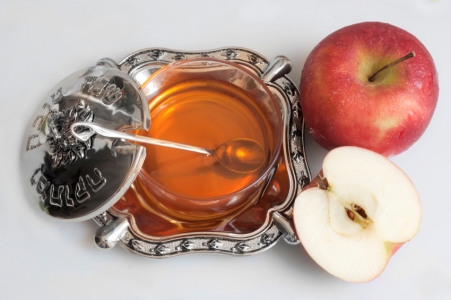Scroll down to the bottom of the page to download the full PDF.
INTRODUCTION
The original ritual foods for Rosh Hashanah are mentioned in the Talmud (Horayot 12a) as part of a discussion of omens and the efficacy of symbolic acts:
Abaye taught: Now that you have said that an omen is significant, each person should make it a habit to eat at the beginning of the year, kara [gourds, e.g. pumpkins or cucumbers], rubia [fenugreek, a seed herb], karti [leeks], silka [beets] and tamrei [dates].
Rabbi Hai Gaon (10th century) reported the custom of reciting a short prayer over each of the above foods which contained a wordplay on the name of the food. While this ritual continued to practiced mainly by Sephardim, among Ashkenazim the custom arose of eating apples and honey, as an allusion to a sweet year, and of dipping the challah in honey as well, in place of the salt usually used with the challah. In kabbalistic literature, the apple in Songs of Songs (see 2:3 and 7:9) symbolizes both Israel and God. The kabbalists also noted that the Hebrew word for honey (devash) has the same numerical equivalent — 306 — as the phrase Av harakhamim, Father of mercy, and thus evokes Divine compassion. The challah and honey ritual is said to derive from the juxtaposition of the images in a verse in a Psalm (81:17) sung by the Levites in the Temple to accompany the Rosh Hashanah sacrifice: “He fed them [Israel] the finest wheat [i.e., the challah]; I sated you with honey from the rock.”
Added to the tradition was the eating of pomegranates and fish (based on their fecundity, and not on a wordplay), and the head of a sheep, which reminds us of the ram that took Isaac’s place in the akedah, the binding of Isaac. The statement made while eating the head, “that we be as the head, and not as the tail,” comes from a verse in Deuteronomy (28:13) meaning, may we be strong and not weak. The authorities also allowed heads of other animals to be used.
The foods and prayers associated with this seder have always been reconstructed in light of the vernacular of the community. In Eastern Europe it became customary to eat carrots for Rosh Hashanah, because the Yiddish word for carrots, mehren, also means “increase.” Similarly, Ukrainian Jews would give their children chicken livers because their Yiddish name, leberlach, sounds like leb ehrlich, meaning “live honestly.”
We too, continue this chain in our seder today. In our blessings we add imoteinu (our mothers). We have also adopted a few unusual food items, which we call “minhag America.” These additions are marked by an asterisk(*) to prevent any confusion. We hope you enjoy them.
We wish you a sweet and blessed New Year! Shanah tovah!













